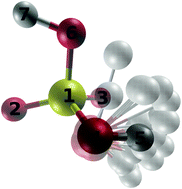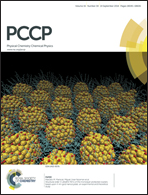Competitive reaction pathways in vibrationally induced photodissociation of H2SO4†
Abstract
Vibrationally induced photodissociation of sulfuric acid into H2O + SO3 is investigated based on reactive molecular dynamics (MD) simulations. Multisurface adiabatic reactive MD simulations allow us to follow both, H-transfer and water elimination after excitation of the ν9 OH-stretching mode. Analysis of several thousand trajectories finds that the H2O and SO3 fragments have distinct final state distributions with respect to translational, rotational, and vibrational degrees of freedom. Rotational distributions peak at quantum numbers j ≤ 5 for water and j ≈ 60 for SO3. The final state distributions should be useful in identifying products in forthcoming experiments. Based on the MD trajectories, a kinetic scheme has been developed which is able to explain most of the trajectory data and suggests that IVR is very rapid. Typical lifetimes of the excited complex range from several 10 picoseconds to hundreds of nanoseconds, depending on the excitation level. Including temperature and pressure profiles characteristic for the stratosphere in the kinetic model shows that excitations higher than ν9 = 4 can significantly contribute to the photolysis rate. This extends and specifies earlier work in that multi-level modeling is required to understand the significance of vibrationally induced decomposition pathways of sulfuric acid in the middle atmosphere.


 Please wait while we load your content...
Please wait while we load your content...